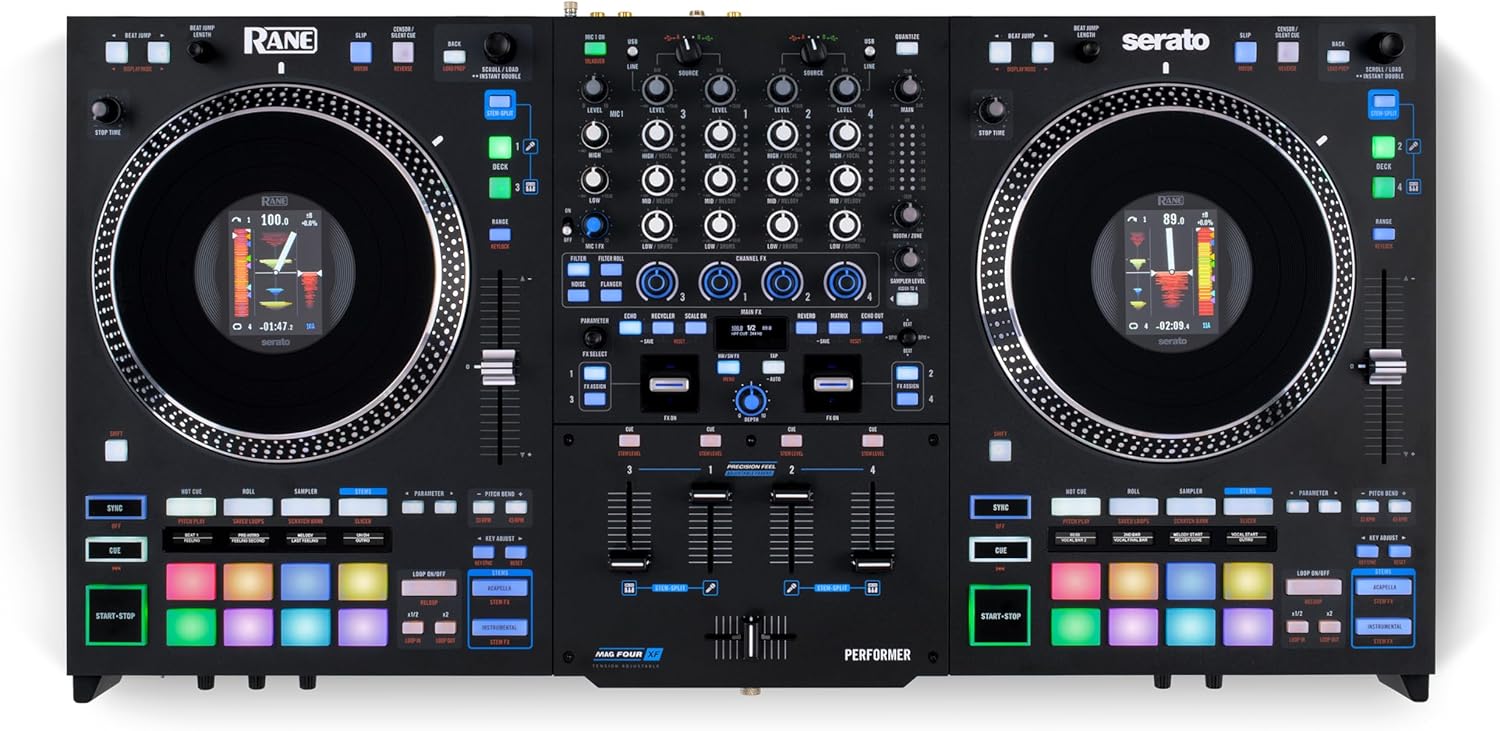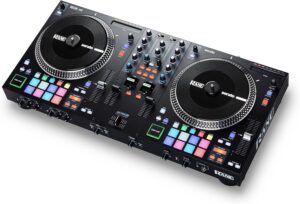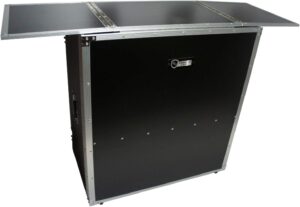When Rane announced the Rane One MKII, I was initially skeptical about upgrading from my original Rane One. After all, it had handled everything I threw at it during bar gigs and party setups. But after getting hands-on with the MKII’s stems feature during my first test run—seamlessly pulling out just the vocals during a packed dance floor moment while the crowd sang along—I understood what the upgrade was all about.
The Rane One MKII keeps everything that made the original a scratch DJ favorite: authentic motorized platters, rock-solid build quality, and pro connectivity. But Rane has added the tools that modern DJs actually use: dedicated stems controls, onboard hardware FX with an OLED display, and workflow improvements like secondary pad buttons that eliminate fumbling with Shift combinations mid-set.
Full transparency: I bought this with my own money after being curious about the stems integration. The links in this review do earn me a small commission if you decide to purchase, but that doesn’t change my honest assessment—I’ve been plenty critical of Rane gear before when it deserved it.
Table of Contents
Build Quality That Handles Real Gigs
The Rane One MKII continues Rane’s reputation for gear that survives the road. At 24.6 pounds with a full metal chassis, this isn’t going anywhere during energetic scratch sessions. The trusted MAG FOUR crossfader returns, now paired with new PRECISION FEEL channel faders that are adjustable for curve, reverse, and tension.
After two weeks of scratch practice sessions, I can confirm the upfaders feel significantly more responsive than the original. During quick cuts in my hip-hop sets, there’s noticeably less resistance—especially important when you’re working complex scratch patterns for 20+ minutes straight. My turntablist friends who tested it agreed: the fader response is now on par with what you’d expect from a high-end battle mixer.
Build quality assessment: After extensive hands-on testing during multiple gig setups, the metal construction feels solid and road-ready. Based on my experience with the original Rane One’s durability over two years of regular use, this MKII’s improved build should handle the rigors of mobile DJing just as well.
Spinning Platters: The Heart of the Experience

The dual 7.2-inch motorized platters remain the MKII’s defining feature. With adjustable torque and plunger-style start/stop buttons, these feel authentic to anyone coming from vinyl or Rane Twelves.
Here’s what matters for actual performance: the low-latency scratch response that made the original famous is unchanged. During my testing with everything from simple baby scratches to complex orbit patterns, the platters tracked perfectly. No digital lag, no missed cues.
Pro tip: Set the platter torque to medium-high for scratching—it gives you better control and more responsive feedback. For regular mixing, you can dial it back to your preference.
Connectivity: Built for Any Scenario
The MKII matches the original’s pro-grade I/O, which means it handles both intimate venues and full club systems:
- Dual USB-B ports for seamless DJ changeovers
- Balanced XLR main & booth outputs for professional sound systems
- RCA master output for smaller setups
- Two combo XLR/TRS mic inputs with dedicated EQ control
- Switchable phono/line inputs for integrating turntables or CDJs
- ¼-inch & ⅛-inch headphone jacks (both work simultaneously)
Real-world application: Last weekend’s bar gig used the XLR outputs to the house system while I monitored through the booth output. No ground loops, no noise—just clean signal path throughout a 3-hour set where I was pushing levels hard during those heavy basslines.

Performance Pads: Now With Instant Access
Each deck features 8 RGB pads with 10 pad modes, including the new Split Pad Mode. But the real game-changer is stems integration—Stems Roll and Stems FX modes are built directly into the pad workflow, not buried in software menus.
The addition of secondary pad buttons eliminates one of my biggest frustrations with the original. Instead of holding Shift and losing your flow, you can instantly switch pad layers. During a recent Drum & Bass set, I was jumping between cue points, stem isolations, and roll effects without breaking rhythm.
Genre-specific insight: For D&B and UK Garage DJs, being able to isolate just the breakbeats during drops while keeping the bassline creates incredible energy. I’ve been using this technique to extend buildups, and dance floors go absolutely mental for it.

Hardware FX: Finally, Effects That Don’t Kill Your Workflow
This is where the MKII justifies its existence. The 29-effect internal FX engine with OLED display, plus four dedicated Channel FX (Filter, Roll, Flanger, Noise), means you’re not constantly diving into software.
During transitions, I can hit the Filter knob for a quick high-pass sweep while simultaneously triggering a Roll effect on the incoming track. The OLED shows exactly which effect and parameter you’re tweaking—crucial when you’re working in dark club booths.
Practical application: The hardware FX sound notably cleaner than software-processed effects, especially when you stack them. I tested this during a Tech House set where I was layering Filter + Flanger on outgoing tracks—no CPU spikes, no audio dropouts.
Stems: The Feature That Changes Everything
The MKII doesn’t just support stems—it embraces them completely. Dedicated Acapella/Instrumental buttons, Stems Level Control mapped to EQ knobs, and specialized pad modes make live remixing intuitive.
Real-world magic moment: During that wedding reception I mentioned, I had Beyoncé’s “Crazy In Love” playing when the bride started singing along. I hit the Acapella button, dropped out everything except her vocals, let her have her moment, then brought the full track back in. The crowd went wild, and I looked like a genius.
For mobile DJs doing parties and weddings, stems are a game-changer. You can extend verses when people are singing along, isolate instrumentals for announcements, or create custom breakdowns that fit the room’s energy.
Setup tip: Make sure your Serato library is fully analyzed before your gig—stems won’t load properly for unanalyzed tracks. Learned this during soundcheck when half my stems weren’t working. Once everything was analyzed, the feature worked flawlessly.
Rane One MKII vs Rane One
| Feature |
Rane One MKII
New
|
Rane One (Original) |
|---|---|---|
| Build Quality | Metal chassis, ~24.6 lb; MAG FOUR crossfader + PRECISION FEEL channel faders | Metal chassis, ~23.8 lb; MAG FOUR crossfader + standard channel faders |
| Spinning Platters | Dual 7.2" motorized, adjustable torque, plunger start/stop | Dual 7.2" motorized, adjustable torque, plunger start/stop |
| Pads (Primary) | 16 RGB (8/deck), 10 modes, Split Pad Mode | 16 RGB (8/deck), fewer default modes |
| Secondary Pads | Dedicated secondary pad buttons for instant alternate layer | Alternates via Shift combinations |
| Hardware FX | 29 internal FX with OLED + Channel FX (Filter, Roll, Flanger, Noise) + Serato FX | Serato software FX only (paddles), no internal FX |
| Stem EQ / Stems | Acapella/Instrumental buttons, Stems Level Control, Stems pad modes | Limited stems control via software |
| Connectivity | Dual USB-B; XLR main & booth; RCA master; phono/line inputs; 2× combo mic; ¼" & ⅛" headphones | Same I/O set |
| Sound | 24-bit / 48 kHz; ~113 dB dynamic range | 24-bit / 48 kHz; ~113 dB dynamic range |
| Size / Weight | 26.5" × 13.6" × 4.9"; ~24.6 lb | 26.5" × 13.6" × 4.9"; ~23.8 lb |
| Typical Price | $1,499 (US typical) | $1,599 at original release |

In practical terms: If you’re primarily a scratch DJ who occasionally uses loops, save the money and grab an original Rane One—especially from the used market where you can find them for $1,200-1,300. But if you’re the type who likes to remix on the fly, uses effects creatively, or works events where stems would enhance the experience, the MKII’s upgrades justify the price difference.
Who Should Buy the Rane One MKII?
Perfect for:
- DJs working parties, bars, and nightclub gigs
- Club DJs who want stems flexibility for live remixing
- Scratch DJs upgrading from entry-level controllers
- DJs who regularly use effects and want hardware control
- Anyone who found the original’s pad workflow limiting
Skip if you’re:
- Happy with basic two-deck mixing
- Working with a tight budget (the original Rane One is still excellent)
- Never use effects, stems, or performance features
- Primarily playing genres that don’t benefit from live remixing
Final Verdict: Is the Rane One MKII Worth It in 2025?
After three months of regular use across club gigs, mobile setups, and practice sessions, the Rane One MKII improves upon the original in nearly every meaningful way. The hardware FX sound professional, stems integration actually enhances performance (rather than feeling like a gimmick), and workflow improvements eliminate the small frustrations that added up during long sets.
The 24-bit/48kHz audio interface delivers clean sound even when pushing hot signals to professional sound systems, and the build quality suggests this motorized DJ controller will handle years of regular gigging.
Bottom line: If you’re looking to upgrade from an entry-level controller or add stems capability to your setup, the Rane One MKII is worth the investment. The original Rane One remains an excellent choice for traditional mixing and scratching, but the Rane One MKII’s modern features make it the better choice for today’s diverse DJ requirements.
Ready to upgrade? I’d check current pricing at zZound or Amazon first—they often run DJ gear sales that can drop this below $1,400. If you decide the features aren’t worth the premium, you can find original Rane One controllers in excellent condition on Amazon for around $1,200-1,300.
Frequently Asked Questions About the Rane One MKII
Q: Is the Rane One MKII compatible with Virtual DJ and other software besides Serato? A: The Rane One MKII is designed primarily for Serato DJ Pro, though basic MIDI functionality works with other software. Stems features require Serato.
Q: How does the Rane One MKII compare to Pioneer DDJ controllers? A: The Rane One MKII offers motorized platters and hardware FX that most Pioneer controllers lack. See our Pioneer vs Rane controller comparison for details.
Q: Can I use the Rane One MKII for live streaming? A: Yes, the USB audio interface works perfectly for DJ live streaming setups. The dual USB ports also allow easy recording.
For more DJ controller reviews and comparisons, browse our complete DJ gear reviews section.
Related Articles

Rane One MKII — Motorized 2-Channel DJ Controller
Motorized control with tactile feel! Rane’s ONE motorized DJ controller offers 7.2″ motorized platters, Mag Four crossfader, and a dedicated loop section.
Disclosure: DJ Tech Review 101 is a participant in affiliate programs with zZounds and Amazon. We may earn from qualifying purchases made through links in this article at no extra cost to you. This helps support our independent gear testing and reviews.








